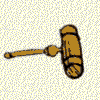

|
|
John Williamson Crary left Ohio on a flatboat, down the Mississipi, and migrated to Pensacola, Florida. There, he used his training as a brickmaker to make a local brickyard a success. About 1859, he helped establish the town of Bluff Springs, north of Pensacola, but the outbreak of war stalled development. Bluff Springs has abundant clay deposits, allowing him to establish a brickyard, which operated for a number of years. The senior Crary died in 1897. Son Will Crary took over operations at the brickyard, but that venture eventually died out. Other things were tried. There was a grist mill, a power plant, a sawmill, a swim resort, a gas station and a general store. For the past 40-50 years the family has operated a dairy. |
|
|
The story goes that a fellow got off the train one day in 1933, noticed the old brickyard, and suggested that the family take up pottery. It just so happened that the man was a potter. According to Dr. Alfred Frankel's "Old Florida Pottery..." the man's name was "Pie" Pylant. Workers at Crary Pottery |
Bricks from the brickyard
were used to build a small kiln onto the side of the gas station,
which became the retail sales outlet. The old gas-powered
gristmill (there was also a water-powered mill) building, across
the road (US 29) became the place where the pottery was turned.
With today's traffic we can't imagine trying to get across
the road with a load of churns! |

Crary
Pottery Store--Kiln is brick structure at right
|
Will was reportedly so excited by the sight of the first pottery from an improved kiln that he had a heart attack and died. His sons John and Martin took over. One of the boys would stay and mind the homefront while the other would load up the old truck and set out in search of markets for their wares. South Florida was not a good market for them, but Alabama and Georgia were. Some of the product made it as far north as New York. As the Great Depression ended, pottery works in Kentucky, Ohio and Indiana began flooding the market with cheap pottery, putting an end to Crary Pottery in 1939. The photos show a sampling of the wide variety of quality pottery produced by Crary Pottery. For more information, see Fred Frankel's "Old Florida Pottery, Potters in Paradise, The Collectors Guide to History, Makers and Marks, 1859-1966." |

Bookends,
figures, etc., at Crary Pottery

| Page copyright 2003 by Neal Collier and Flomaton Antique Auction. Photo restoration by Neal Collier, from Crary family negatives. Feel free to print these pages for personal use. Any commercial use of code or images is forbidden without permission. Hi-resolution images are available for license. |